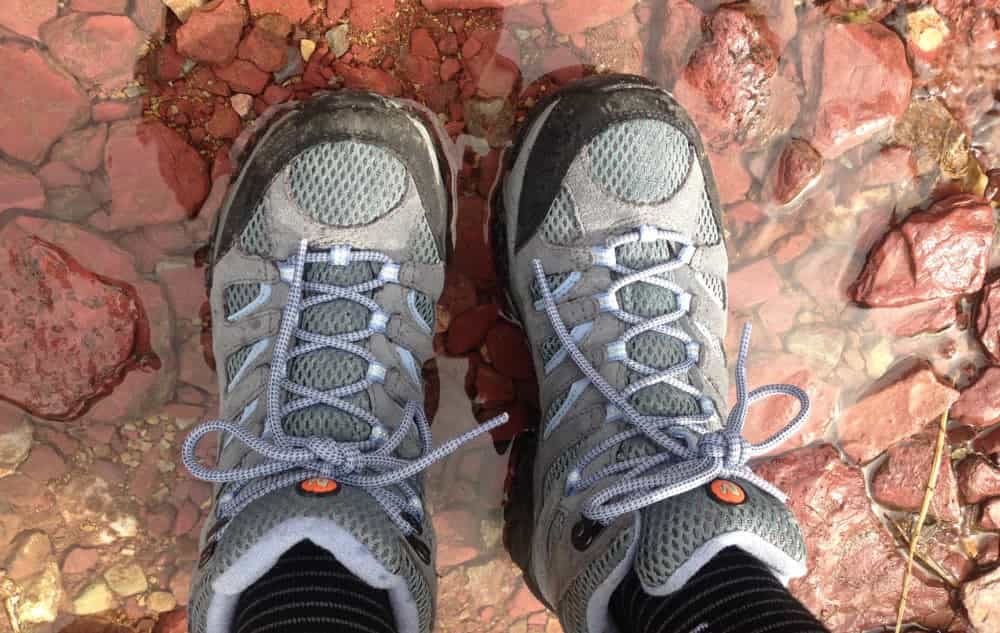The world's most stunning hiking trails, charming streets and cultural sites are begging you to explore them. Obtaining the right gear and trying it out beforehand will definitely help you get them most out of your hiking trip.
Choose Your Footwear Wisely
Unless you're doing some hardcore hiking, you likely don't need heavy-duty boots for your adventure. Lightweight trail running shoes or "light hikers," which have the stability of boots without the added weight, work great for more causal hiking trips. These shoes offer the perfect balance of tread and comfort for trips like those in Cinque Terre & Tuscany, where you can expect to ramble down old, narrow streets in historic villages as well as meander through vineyards. Light hiking boots that wrap around your ankle are well suited for more rugged hiking trips, like those in Glacier & Waterton Lakes, where mountain streams make rocks slick and trails cut into the mountains, making a grippy tread preferable.
Walking Sticks
Walking sticks, or "trekking poles," have exploded in popularity in recent years as their myriad benefits have been widely acknowledged. By greatly reducing the impact and fatigue on your legs and knees, adding stability for uneven trails and water crossings, and expanding the workout to your upper body, trekking poles are a valuable enhancement to the hiking experience. With today's foldable, lightweight and packable poles, it's easier than ever to pack them along and enjoy them on the trail (or cobblestone!).
To Waterproof or Not to Waterproof?
Waterproof shoes have their benefits and drawbacks. Waterproof shoes may keep water out, but they will typically be a bit heavier and have less ventilation than a shoe without waterproof materials. Additionally, your feet may not stay entirely dry in waterproof shoes because hot days can lead to perspiration, which can be uncomfortable in less-ventilated shoes. So give some thought to where you'll be hiking and what the likely weather and trail conditions will be, then prioritize accordingly. If you opt for waterproof, look for more "breathable" waterproof shoes made with Gore-Tex or other materials that allow sweat vapor out. Make sure to pack a waterproof jacket to stash in your day bag as you never know when storms may roll in, whether you're hiking glaciers in Alaska's Kenai Peninsula or walking along seaside cliffs in Ireland's County Kerry. Shell-style jackets (without an insulating lining) are your most versatile (and packable!) option—you can wear them over a t-shirt in tropical locations or over warm base layers in colder regions.
Break-In Those New Shoes!
Whatever you're putting on your feet, be sure to wear them in well before your trip. New hiking shoes may cause blisters or general discomfort, which will be a major detraction from your experience. So go ahead and break them in by taking some short walks, then moderate hikes, before you embark on your big trip. You'll be much more comfortable if your feet are already used to your shoes.
Layer Up
If you'll be hiking in high elevation regions, such as through mountain villages in the French & Italian Alps, temperatures can drop quickly, even in the middle of summer, so plan to bring extra layers. Don't default to a big clunky jacket; a small lightweight extra layer—like a windbreaker or long-sleeve wool shirt—will pack small and may be all that you need, especially when paired with your waterproof/windproof layer mentioned above. Check the forecast in advance of your departure and be prepared for mother nature to surprise you.
Dress to Dine
While it's not always essential to bring formal dining clothes on your hiking trip, you may want to be able to dress up for a night or two on the town, particularly if you're traveling with Backroads and dining at some truly special restaurants! Dresses, slacks and shirts that don't wrinkle easily are a great choice. For ladies, a polyester or knit dress can look as fresh as it would out of your closet as it does from your suitcase. For both men and women, look for "wrinkle resistant" or "non-iron" pants, button-downs and tops.
Putting thought into what you put in your suitcase can make a huge difference in your hiking trip. If you're comfortable and prepared, you'll be ready to take on the world!


















